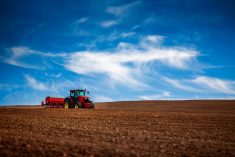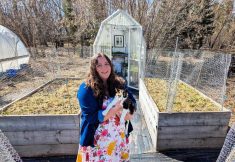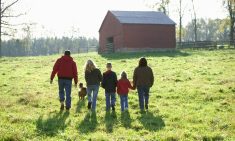We always wanted to milk cows, but we never thought it would ever happen,” Kevin Conroy remembers. “The land prices in Ontario just went up and up and up.”
Then, one day a decade ago, Kevin and wife Diana, who worked 103 acres in Ontario, were out for a Sunday drive and they saw a nice little farm for sale. “Mostly being nosy,” Kevin admits, they looked into whether they might be able to afford it.
Back home, they sat down with the bank. If they sold their current operation they just might have enough to get started in dairy.
Read Also

Farmland values: assumptions and realities
Where farmland values are headed and what decisions farmers should make
“From that point on, we went farm shopping,” Kevin says.
Then, reality hit home with a thud. “We looked in Ontario and couldn’t find anything we liked.”
So they tried further afield. They scoured Cape Breton, then P.E.I., then Nova Scotia and finally found a property as a private sale in New Brunswick at the end of 2013.
They took possession the next August and it seemed the decision to look east had paid off.
“We ended up here because of the pricing,” says Kevin. “We only had a certain amount of money that we could spend, so we were limited in the size of farm we could get. The farms in the Maritimes are smaller and less expensive … That’s where it made it feasible to invest down here in a farm.”
But there was some buyer’s remorse coming. Their dream turned into a nightmare.
They’d been too eager. They’d jumped too fast.
“The farm kept flooding to the point where we would have to swim our cows out of the barn and the milk tank was floating in the milk house,” recalls daughter Hanna.
“It was a lot of water, and we weren’t aware of that when we purchased the farm originally.”
So the family went farm shopping again, finally finding their current operation near Upper Hainesville, about 45 minutes north of Fredericton. Today, the family milks between 40 to 45 cows with a robotic milker and they run 45 acres of corn and 200 acres of hay for feed.
“It’s been a family effort … but here we are, eight years later,” says Hanna.
But others get a lot of the credit too, she adds. “New Brunswick has been very welcoming and very open. The other farmers here are always willing to help and lend a hand.”
It helped too that the Conroys reached out as well.
As a young person relocating to a new province, Hanna joined the local 4H club and got involved in other community groups to meet people and develop a supportive farming network of her own. “That’s how you’ll learn and meet people down here. It just makes the transition easier.”
There have been other challenges along the way as they’ve built, and then rebuilt, their dairy operation. Veterinary services are spread thin in New Brunswick and the same goes for equipment dealers and input suppliers.
“But you’re going to have challenges no matter what you do,” Hannah says.
“There’s always going to be obstacles you have to overcome, but they’ve led us to where we are today. We’re situated now on a better farm with more land availability.”
“It’s been the right move for us.”
Somewhere in between
Our second story takes us to Germany in early March 2020 when, despite four hours on the phone with Air Canada, the Teerling family still didn’t have any clear answers about their Canadian flight.
Nobody else had answers for them either. Every news source was buzzing with talk about this new thing called COVID-19, but no one actually seemed to know anything.

Somehow, the Teerlings would just have to make a choice. Maybe they should go to the airport and hope their family of four would all be able to get on a plane in the next day or two?
If they they did that, though, and if they did leave Germany, would they actually be able to come back to finish clearing out and selling the home farm?
But on the other hand, if they didn’t move fast, would they lose a whole summer on the new place, meaning their two years of planning how to get their Maritime farm up and running would go off the rails before they even started?
“Finally, at around 10 p.m. we decided,” Christiane recalls. Their 18-year-old son Ian would have to stay to look after things in Germany. The others would jump on the next flight.
It worked. Today, Christiane and husband Jan own and operate Lindsay Lake Farms in central Nova Scotia, an hour northeast of Halifax, with sons Ian, now 20, and Cedric, 13.
Christiane remembers it vividly. “Our oldest son was stuck in Germany, having to run the farm on his own at just 18 years old.”
The family had bought the Nova Scotia farm in 2019, although they hadn’t initially expected to move there.
They’d owned 40 acres in Lower Saxony, where they produced red and fallow deer on mostly rented land for their butchery and farm-to-table catering business. But it wasn’t enough.

“We bought this place here because our farm in Germany was far too small to get the vision we had for our business,” says Jan. “We loved farming and farm-to-table, nose-to-tail. We just felt like we wanted to do it on our own land for ourselves, always with respect for the animals and for nature.
“So we had to decide — staying or growing. So we decided to grow.”
Jan had been looking at real estate listings online for a while, mostly in New Zealand, when he came across a listing for an 1,100-acre property on the edge of a lake, nestled among hills of hayland and forest. It was exactly what they were looking for — only it was in Nova Scotia, not New Zealand.
From 5,000 miles away, the farm looked perfect, so the family booked a week-long trip to Canada to tour the province and check out the property over Easter holidays.
“It was the worst weather you could think of — snowy, windy, gray, ugly,” says Christiane. “We didn’t see the lush green pastures. It was just brown fields everywhere. But for all that, we could see the beauty. We saw everything we had dreamt of.”
And as the family drove their rental car up the long lane to the farmhouse, their navigation system showed, “You have reached your destination.”
“I knew that was the beginning of our new adventure,” Christiane says.
But the family could have little idea of the adventure that awaited them as they started packing their German farm into containers to ship overseas.
“We bought the farm — and then COVID started,” says Jan. “Ian was stuck in Germany, we were stuck in Canada, and we had to figure out our next steps.”
The first priority was managing the farm back in Germany, including the 250-head of deer they still needed to sell. So with the support of his parents over WhatsApp, 18-year-old Ian took on the role of farm boss.
“Ian was doing online schooling and managing the farm — feeding the animals, doing the hay. It was all on his shoulders, but he managed really well,” Christiane says.
But then, there were good surprises too. A neighbour helped with groceries once they arrived at their new home in Nova Scotia’s Musquodoboit Valley.

“She went shopping with me on WhatsApp at Sobeys for three hours, and the shelves were already empty,” says Christiane, recalling the early days of the pandemic. “There were lots of things that weren’t available, but she made sure that when we arrived, everything was in the fridge for us. I appreciated that so much.”
By then, quarantining seemed almost easy. “We didn’t have to do anything. We could just explore the farm, and that was nice.”
In August 2020, Jan was finally able to fly back to Germany to help Ian get the rest of the farm packed and sold. Most everything they owned — forestry equipment, tractors, a mobile butchery, a food truck — was packed into shipping containers. The family even shipped their Clydesdale mare Ivy in a container, after long months of training her to be comfortable in it.
“We came to a point where we had to decide, Do we sell everything, or do we take it with us? Nobody was interested in buying it because of the pandemic, or they wanted it really cheap,” says Christiane. “This would have meant we would have lost a lot of money. So instead of selling, we used the money we would have lost to send it over here.”
But it was almost impossible to plan ahead, she added.
“With the pandemic and the interruption in the supply chain, it was hard to organize everything in time because there were delays in the shipments, and containers weren’t available,” she says.
While Jan and Ian worked to get the farm sold in Germany, Christiane and Cedric were left in Canada to organize the farm here.
“Cedric had to be the farmer here that summer, driving the tractor and doing the hay all by himself at just the age of 11,” she says. “I was really thankful that the kids had been raised that way, to be responsible and hard working. It made it easier because it wasn’t just all on my husband and myself.”
Even so, the distance was hard on the family.
“There was one day back in 2020 when my husband and son were back in Germany and I was all alone here. I was so angry and mad, wondering what we were doing out here,” Christiane recalls.
“I’d never been apart from my husband more than a week before this in almost 30 years together, … we wanted to move here and live in Canada, but I didn’t think that would mean being apart from my family for so long. That wasn’t part of my plan.’
For the last week before they left Germany, Jan and Ian barely slept. Their days were spent packing and cleaning equipment; their nights were spent driving the equipment down the highway at tractor speeds, seven hours to the Port of Hamburg.
“I got a call Friday afternoon, 5 o’clock German time, from my son. ‘Mom, we won’t make it tomorrow. Look how it looks here,’ he says, showing me on the camera. ‘There’s nothing done.’
“Can you imagine, 20 years living in a house, having a business, what you all have to pack? Even though they had packed for three months, it felt overwhelming to see everything that was left,” she says. “They packed until one in the morning, and then they got changed, said their last goodbye to the house, hopped on a plane, and came home.”
Two weeks later, the first containers arrived. “When they got to Canada, it felt like a triumph,” Christiane says.

Now that the family has been settled all together on the farm for a year, they’ve begun to build the farm they’ve been dreaming of. A herd of bison will soon graze the rolling fields and Jan is working to get his mobile butchery licensed so they can process their own animals on-farm.
Everything they produce on-farm will be sold in their country store and restaurant. Earlier this year, the Teerlings purchased the old co-op building in Middle Musquodoboit, and it has enough space for an authentic German eatery, a drive-through take-out window, a bakery, a farm store, a butcher shop, and a meat counter for their bratwurst and other meat products. (Not to mention plans for a beer garden out back.)
“There are so many options that we are now able to figure out. Most of the ideas have been in our brains for years, and now it’s so exciting to see them come true — sometimes not fast enough for us,” Christiane says with a laugh.
“It feels like we’ve had to be patient, but step by step, it’s come together.”
Increasingly, they’re convinced Nova Scotia was the right choice.
“It’s a different life, but it’s the life we’ve dreamt of,” Christiane says. “It feels like a gift every day to wake up and have this farm.”
Getting educated
For Rachel Dalton and her husband Jason, a warrant officer in the military, buying their farm near Hoyt, New Brunswick, back in 2015 seemed like the only move for their growing family.
“We wanted to buy a farm property where we could have strong roots for our kids. I wanted my kids to grow up with memories of a place, of running through the fields,” says Rachel. Her husband had been posted from Petawawa, Ont., to Gagetown, N.B., the closest they could get to their home province of Nova Scotia.

But their first attempt at buying their farm — an 80-acre foreclosure they fell in love with — didn’t work out.
“We actually lost this place in a bidding war, even in 2015,” says Rachel, adding that they had looked at other properties but couldn’t see themselves anywhere else.
“We’re both Maritimers. We love the lifestyle, the closeness to the ocean, the people, everything. We had talked about buying a farm in Ontario, but like everybody else, we just couldn’t afford a stick in Ontario.
“And even then, we could only afford this place because it was being sold by the bank.”
Because it was a military move, they knew they had to leave Ontario by a certain date, but as that date approached, they still didn’t have a backup plan.
“So when the bank called us to let us know the other offer had fallen through, that was good, because I was legitimately refusing to even consider any other option,” Rachel says with a laugh.
Today, Rachel has a herd of sheep and alpacas that she keeps for their fibre, which she processes into yarn, handwoven clothing, and roving and fibre for hand-spinning.
“We do a lot of sales online, especially during the pandemic,” she says. “Being that we’re not a food product, we can ship anywhere with very little restriction. It’s interesting — and difficult, I guess — to be both farmer and chief media executive. Sometimes I feel like I’m captaining a drowning ship, but there’s a lot to do in this day and age to run a business online. When you add in farming on top of it, it can get interesting.”
And the farming side of the things has definitely come with its own learning curves.
“Before we moved out here, we lived in a subdivision and (we) were those people — ‘Oh, I visited a farm once. I volunteered on a farm when I was younger. I know farming.’ I want to punch the old us. We were so obnoxious,” Rachel says with a laugh.

“I don’t know how many times we’ve had somebody stop by the farm and be like, ‘Oh, what are you doing?’ And we’ll explain what we’re doing, and they’ll be like, ‘Mmm, no, it doesn’t work like that. This is how you do it.’ And they’ll take a ridiculous amount of time out of their life to explain to us how, like, making hay works.
“We’ve met so many amazing people, locals from the surrounding community, who have shown us how to do things or who have helped us move hay when we had no idea how long it would take. We would have drowned and been gone a long time ago if it wasn’t for the community here really ensuring that we kept our heads above water.”
Living rurally has also been a challenge after living in an urban subdivision just outside of base.
“If we wanted KFC at 2 o’clock in the morning, it was a two-minute drive. So being out here was a big challenge in the beginning,” she says. “We’re about an hour from Fredericton and half an hour from Oromocto, so if I run out of potatoes, it’s quite a drive. We really had to change the way that we do everything, from grocery shopping to clothing shopping.
“Now, if we want to go to town with the kids, it’s an entire day experience, and we have to get everything done. We do it all in one credit-card-melting trip.”
Their rural location has also meant slow, intermittent internet service and cellphone coverage — not ideal for a business that does the bulk of its sales online.
“We went through three or four providers because they all promised they had coast-to-coast coverage, but apparently Hoyt is not within that coast-to-coast,” she says. “We’ve ended up putting a lot of money into services that work for us … before if we had an important call, we’d almost have to go to Oromocto to make it. There’s been a lot of work-arounds and things to live with living rurally.”
Even so, Rachel, her family and their herd have found an unexpected welcome in those New Brunswick hills they now call home.
“What I’ve noticed farming in the Maritimes is that farming out here now, especially for the hobbyist or small farmer, doesn’t seem to be so much the classic growing cows and selling beef,” says Rachel. “It seems like it’s more about the connections — like the people who have been having success have been doing a lot more value-added, agri-tourism, and education as well.
“There’s such an interest in local folks to see what is happening on farms. We easily get 1,500 people through a year who just want to come out and walk in a barn, see the animals, and get that one-on-one experience with them. You can’t just walk on any old farm and do that.”

A small start
Slow growth has also been the path to success for Tarsila Stoeckicht and Jason McCrimmon over the past seven years — half of those spent learning to farm in Ontario before their move to Nova Scotia’s North Shore in 2019.
“We were living in Toronto. City life was getting to us, and we had this idea to buy land,” says Tarsila, who now runs Way to Grow Gardens with Jason near Ardness, Nova Scotia. “Jason is a little more rational, so he says, ‘If we’re going to buy land, let’s see what we can do with it. Let’s try farming out before diving into it.’”
So in 2015, the couple apprenticed on a farm in Ontario before finding a way to farm on their own: “a tiny little place with an apartment and an eighth of an acre to grow a market garden.” After doing that for two years, the couple tried to expand, but couldn’t even find land to rent for a affordable price. So they went back to work as field managers on the farm where they had apprenticed, always keeping an eye out for the perfect property within their budget.
And at the end of 2019, the couple found that property, 12 acres perched on a hill on Nova Scotia’s North Shore where both the ocean winds and the sweeping views of the Northumberland Strait would take anyone’s breath away.
Admittedly, it was the price of land as much as the views that drew them there from Ontario to farm.
“We got in before prices went crazy,” says Tarsila. “But we also just wanted a bit of adventure. We thought it would be nice to be near the water.”
The couple were excited for their first season, planning a CSA box program for the community and a booth at the farmers markets in nearby New Glasgow and Merigomish for their mixed garden vegetables and cut flowers.
And then the pandemic hit.
“2020 was our first year, so it was like, ‘Okay let’s start a farm … in a pandemic…’” says Tarsila with a laugh.
“For it being our first year out here, it was pretty successful. We’re expanding little by little. The community has been very supportive.”
That was a boon for the couple during their transition from Ontario to Nova Scotia farmers, as they “basically had to build the whole business again,” says Jason.
“We sold at the same market in Ontario for two years, and even from year one to year two, we did better. We had more people coming back to us,” he says. “We could see the business expanding and how it could expand more. So we basically had to start that all over again, and we didn’t know anybody here, so we didn’t have that word of mouth.
“But Nova Scotia in general seems to have a supportive local food scene. There are a ton of farmers markets.”
In those early days, the community was a little uncertain about this couple on the hill, growing fresh-cut flowers and market garden vegetables in greenhouses and in fields on a tight three-quarters of an acre.
“I think people thought we were a little crazy,” says Tarsila with a laugh. “We moved here without knowing anyone. We don’t have family here. But before the pandemic, we really tried to put ourselves out there and be part of the community.
“And now that they see how serious we are about it — that it wasn’t just a whim — people are always really surprised by what we’re doing here, by the scale and quality of our vegetables.”
But because they’re producing so much each growing season (enough that it’s now a full-time job for both Tarsila and Jason), their crop plan is “very tight,” says Jason.
“As soon as one thing is done, something else is being planted, with not a lot of down time,” he says, adding that the longer fall in Nova Scotia does offer more time for harvest (sometimes even into December.)
But at the heart of their farm is the soil — which isn’t very good, being highly acidic, but is getting better every year.
“Soil, in our minds and our farming philosophy, is the most important thing, and we’re not willing to compromise on that,” says Tarsila. “In the three years we’ve been here, we’ve been doing soil tests, and for every soil test we’ve done so far, there have been improvements. From our first soil test to our most recent one, all the nutrients are up.
“It’s a lot of work. It takes a lot of time to have these results. But it’s worth it when you see those improvements.”
At this point, between the CSA program, the farmers markets and their farm stand sales, the couple is nearly at their production limit.
“We can’t say how big we want to grow, but we’re probably reaching it already because it’s just the two of us,” says Jason. “We want to keep it at a scale that the two of us can manage together.”
For Tarsila, future expansion is more about investing in the land, rather than growing their production or sales. She envisions a pond for irrigation, a way to channel and gather water, a windbreak of trees, an orchard of fruit and nut trees, and more land to preserve for the wildlife, songbirds, and waterfowl.
“How can we contribute to this land, not just for us but for the next people who get to use it and live here?” she says.
That also means investing in growing the Nova Scotia farming community, she added.
“I’m very much about farming community, so I put effort into connecting with other farmers and building those relationships,” says Tarsila. “I think that’s one of the most important and wonderful things about farming at this scale. You’re all producing very similar things, but I don’t view these other farmers as competition. Our competition is the supermarket.”















